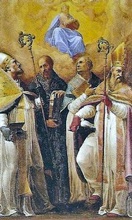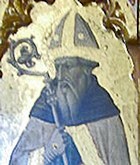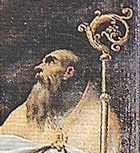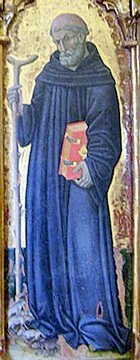


Madonna in Glory (early 17th century)
with SS Eutychius, Florentius, Sanctulus and Spes
attributed to Cristoforo Roncalli,
Santa Maria Argentea
St Spes (28th March)

According to the Dialogues of Pope Gregory I, St Spes built a monastery “in a place called Cample, distant almost six miles from the old city of Nursia”. [This abbey later became the site of the Abbazia di Sant’ Eutizio (see below).] After he had endured blindness for 40 years, God returned to him his sight and told him that he would soon die. This he duly did some 15 days later, “at which time all the monks saw a dove coming out of his mouth, which in their sight flying forth through the top of the oratory being then opened, ascended up into heaven”.
SS Eutychius and Florentius (23rd May)
An entry in the Roman Martyrology under 23rd May reads: “ At Norcia, SS Eutychius and Florentius, monks, mentioned by the blessed Pope Gregory”.
In the Dialogues of Pope Gregory I, Gregory I records that “reverent Priest, Sanctulus” was the source of his information about SS Eutychius and Florentius, who lived as hermits near an abbey outside Norcia (later the Abbazia di Sant’ Eutizio - see above). They were contemporaries of St Isaac (the hero of the previous anecdote in the Dialogues), who had arrived in Spoleto from Syria “at the time that the Goths first invaded Italy” and lived there “almost to the last days of the Goths”. In the anecdote about St Eutychius, when the abbot of the nearby abbey (St Spes or perhaps a successor) died, the monks persuaded St Eutychius to replace him, and he subsequently “governed the abbey many years”. Meanwhile, St Florentius remained alone in their original hermitage.
The legend of these saints based on the account in the Dialogues is documented as BHL 2791.
St Eutychius

Gregory I recorded that St Eutychius was famous for his posthumous miracles, “even in these times of the Lombards”. In particular, his hair shirt was taken in procession during a draught and had the required effect.
The feast of St Eutychius is celebrated in Norcia on 27th June.
Reliquary of St Eutychius (1544)
This gilded reliquary, which contained the hair shirt of St Eutychius, bears an inscription that records its commission by Abbot Giovanni Mensurati in 1544. The reliquary was stolen from the Abbazia di Sant’ Eutizio in 1883. It was subsequently recovered, minus the relic, and moved to Spoleto for security. [Where is it now ??]
St Florentius

St Florentius of Foligno
Ludovico Jacobili (referenced below, at pp. 150-9) included St Florentius among the saints of Foligno, noting that the people of Foligno had celebrated his feast on 1st June and believed that his relics were preserved in the Duomo. He pointed out that Philippus Ferrarius included the following entry under June 1st in his “Catalogus generalis sanctorum” (1625):
-
“Florentius confessor: from the archives of the church of Foligno, where his relics lie” (my translation).
He also asserted that the Duomo of Foligno had been reconsecrated as SS Giovanni Battista, Feliciano et Florentio in 1146, following the extension 0f its nave (albeit that the dedication soon settled on St Felician). Jacobili acknowledged that St Florentius was venerated at Norcia on 23rd May (with St Eutychius) and 27th June, and that his relics were believed to be preserved the Abbazia di Sant’ Eutizio. However, he relied of the opinion of the Dominican scholar, Giovanni Battista Bracceschi (who wrote in the late 16th century), to the effect that St Florentius had been one of the 300 Syrians and a companion of St Vincent (whose life Jacobilli included at pp. 142-9, claiming him as a bishop of Foligno). He suggested that, after the death of St Eutychius, St Florentius had moved to Foligno and that St Vincent had built a hermitage for him outside the city that was known as San Silvestro (later Santo Spirito). When he died there 8 years later, on 1st June of 548 or 550, St Vincent arranged for his burial in the Duomo.
It is, of course, entirely possible that the “St Florentius” who featured in the dedication of the Duomo of Foligno in 1146 and whose relics were venerated there was quite unrelated to St Florentius of Norcia.
Doubles for St Eutychius
St Eutychius of Ferentium (15th April; 15th May)
An entry in the Roman Martyrology under 15th April reads:
-
“At Ferentino in Campania, the martyr St Eutychius”. The related legend (BHL 2779-80) places his martyrdom in the reign of the Emperor Claudius (10 BC - 54 AD).
The Dialogues of Pope Gregory I include an account of a vision in which St Eutychius appeared to Bishop Redemptus of Ferenti and repeated three times: "The end of all flesh is come: the end of all flesh is come". The Lombard invasion happened immediately thereafter (in 568). This vision occurred at a church in Redemptus’ diocese in which St Eutychius was buried. Although the Roman Martyrology places this city in Campania, it was probably Ferentium in Etruria, east of modern Viterbo. Soldiers from Viterbo destroyed this city in 1172 and what survived became part of the diocese of Viterbo.
-
✴St Eutychius is the patron saint of Soriano nel Cimino (a city of Etruscan origin not far from Ferentium) where his feast is celebrated on 15th May. The relics of St Eutychius were found in the church of San Eutizio there in 1496.
-
✴St Eutychius is also the patron saint of nearby Carbognano (south east of Viterbo, which is first documented in 817 as “fundum Carbonianum” in the register of possessions of the Abbazia di Farfa.
St Eutychius the Syrian (15th May)
This composite account is found under 15th May in:
-
✴two legends from the Abbazia di Sant’ Eutizio that are now in the Biblioteca Vallicelliana, Rome:
-
•volume XXIV, folio 105-8 (transcribed by Father Pietro Pirri, referenced below); and
-
•volume XXV, folios 245-6); and
-
✴two volumes of the Leggendari del Duomo di Spoleto
-
•volume 1, folios 213-6 from San Felice di Narco; and
-
•folios 93-5 of the volume from San Brizio.
Each of the entries in Spoleto also has a short addition describing some posthumous miracles (also transcribed by Father Pirri).
The legend is derived from the Legend of the Twelve Syrians, an extended family that travelled from Syria to Rome in the reign of the Emperor Julian the Apostate (361-3). The family comprised St Anastasius, his sons SS Brictius and Eutychius, and nine “nepotes” (best taken to mean other younger relations):
-
✴In the classic version of the legend, the nepotes are named: Abundius and Carpophorus; Laurence; John; Isaac; Teudila; Proculus; Herculanus; and Baractalis.
-
✴In the version from Sant’ Eutizio (which, perhaps unsurprisingly, places Eutychius before Brictius)
-
•“Theotila” (a form of the more usual Teudila) is coupled with Isaac; and
-
•“Paulus” (unknown in other versions) replaces Proculus, perhaps because of an error in transcription.
Julian the Apostate ordered the arrest of the family in Rome, and St Anastasius was beheaded. The rest of the family then fled along via Cornelia, before splitting up at a place called “Pacem sanctorum”. The classic version of the legend largely concentrates from this point on the life of St Brictius, who is now the pater familias, saying of St Eutychius only that he moved to “Lacus Vulsinus” (the Lake of Bolsena), where he spent many years as a hermit.
However, in the legend of St Eutychius the Syrian, the story continues with the information that, after a long time, it pleased God to send St Eutychius to another place. It continues with an explicitly identified extract from the Dialogues of Pope Gregory I that describes the lives of SS Eutychius and Florentius (see above) in Norcia. Here, “magnum et optimum monasterium est constructum” (a large and excellent monastery was built), although the fact that Pope Gregory named St Spes as the builder (the 6th century) was omitted.
The legend then records that St Eutychius died on 15th May. (Since this is also the feast of St Eutychius of Ferentium (above), his hermitage near Lake Bolsena was presumably thought to have been near the Roman city of Ferentium there). His life is not placed in the time of the Goths (as it is in the Dialogues), so the need to reconcile this with his arrival in Rome at the time of Julian the Apostate is avoided. However, the account from the Dialogues of his posthumous miracles in the time of the Lombards is included.
St Eutychius is named in the legend of St Laurence of Spoleto (BHL 4748 d), who was one of an “infinita turba” (boundless multitude) of Syrian immigrants. He subsequently found his way into the Legend of the 300 Syrians, a construct by local scholars in the late 16th and early 17th centuries, in which a large group of Syrian monks arrived in Umbria in 516.
Interestingly, Gregory of Catino seems to have drawn on this version of the Legend of the Twelve Syrians for the account that he gave in his Liber Floriger (1130-2) of the the foundation of the Abbazia di Farfa by St Laurence. This is one of a number of examples of the close association of the two abbeys in the early 12th century.
SS Maron, Eutychius and Victorinus (15th April)
An entry in the Roman Martyrology under 15th April reads: “the holy martyrs Maro, Eutyches, and Victorinus, who, along with blessed Flavia Domitilla, had been banished to the island of Pontia for the confession of Christ. Being recalled in the reign of Nerva, and having converted many to the faith, they were put to death in different ways by the judge Valerian, during the persecution of Trajan”.
Related entires in the Roman Martyrology are:
-
✴under 7th May: “At Terracina in Campania, the birthday of blessed Flavia Domitilla, virgin and martyr, and niece of the holy martyr, the Consul Flavius Clemens. She received the religious veil at the hands of St Clement, and in the persecution of Domitian was exiled with many others to the island of Pontia, where she endured a long martyrdom for Christ. Taken afterwards to Terracina, she converted many to the faith of Christ by her teachings and miracles. The judge ordered the room in which she was with the virgins Euphrosina and Theodora, to be set on fire, and she thus completed her glorious martyrdom. She is also mentioned with the holy martyrs Nereus, Achilleus and Pancras, on the 12th day of this month.
-
✴under 12th May: “At Rome, on the Ardeatine Way, the holy martyrs Nereus and Achilleus, brothers, who underwent a long exile for Christ in the island of Pontia with Flavia Domitilla, whose chamberlains they were. Afterwards they endured a most severe scourging. Finally ... they were beheaded ....
The legend of SS Maron, Eutychius and Victorinus (BHL 6064-5) seems to have been written at the Abbazia di Farfa, as an addition to the earlier traditions of the other saints. In this legend, the three saints are condemned to hard labour, and martyred in turn at various points on Via Nomentana or Via Salaria, the roads that linked Farfa with its other major monasteries in Piceno:
-
✴St Eutychius was martyred at the 16th milestone on Via Nomentana, and can probably be associated with St Eutychius of Ferentium above;
-
✴St Victorinus was drowned in a sulphur spring at Aquae Cutiliae, at the 60th milestone on Via Salaria (near modern Cittaducale, where Farfa owned property) and his body was taken to Amiternum (near modern l' Aquila); and
-
✴St Maron was martyred at the 130th milestone on Via Salaria. This was probably at “Firmana, ad Sancti Marotum” (near modern Monteleone di Fermo and the monastery of Santa Vittoria in Matenano, which also belonged to Farfa).
It seems likely that the legend was written in ca. 930, as the monks began to re-establish themselves at Farfa having abandoned it in the face of Saracen attack and moved to Santa Vittoria in Matenano.
See the page on St Maron, whose cranium is venerated in Foligno.
Read more:
P. Pirri, “L' Abbazia di Sant'Eutizio in Val Castoriana presso Norcia e le Chiese Dipendenti”, Rome (1960)
The legend of St Eutychius from the Biblioteca Vallicelliana (Volume XXIV) is at pp 259-63, followed by the short addition from Spoleto.
L. Jacobili, “Vite de' Santi e Beati di Foligno”, (1628)
Return to Saints of Norcia.

